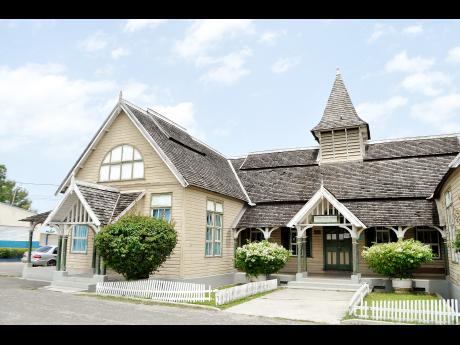A walk back in time to Sav
The Savanna-la-Mar of the '60s was a very happy, peaceful, respectful, fun-loving, and God-fearing town. The tranquillity was only disrupted by sugar trucks racing to the wharf; the pealing of church bells on Sundays; and the annual frantic urgency of Christmas Eve with fire crackers, starlight, fifi, horns, and mouth organs.
Christmas would also bring the cracking of the masquerade's whip on Dalling Street and mobile carolling from devout Salvation Army members. Once in a while, the loud protests of a resistant ram goat that had no interest in being curried could be heard.
The only guns I ever saw were toy guns bought at Thompson's Drug Store, Guyadene's, or at Olympia Pharmacy, and the only slaughter was of animals for meat at the town market on weekends. Chances were far greater of getting attacked by centipedes (40 legs), wasps, red ants, or black spiders than getting hurt by human hands.
Exceptions to this rule were extremely rare.
A profound respect to keep the peace was a required trait for all citizens, perhaps a by-product of the nearby Frome riots decades earlier.
But it was especially demanded from children. My family had a friend who lived at 77 Great George Street - Sue Jolly. She was related to then governor general Sir Clifford Campbell, and we the children were expected to greet her when passing her parlour with a robust "Good morning, Mrs Jolly, and how are you?", or we'd hear about the omission upon arrival back home.
Sav was a seaside town, so there were lots of beach trips to Bay Bottom, to Sabito at Bluefields, and river trips to Sweet River or Roaring River.
At Christmas time, my aunt from New York would always visit with her husband, who was a singer with United Artists, and I would get to spend a week or two at the Vickers Beach Cottage in Belmont, a stone's throw away from the Tosh property.
delicious crab backs
I remember a lady in the village baking the most delicious crab backs. They may have been fifty cents per dozen, but at the time, they seemed expensive.
On weekend visits to nearby Shewsbury where my sister lived, I was startled to see a boy climb a tree to raid blue eggs from a bird's nest. Negril then with its two hotels and zillions of crabs was for church outings, and Big Bridge, a nearby community that sits on the edge of the Cabarita River, had all the shrimp and gadammi (a river fish) one could ever eat.
The parish generally had so many crabs roaming the streets by night that you could set an uncovered pot with boiling water overnight and be sure that the crabs would crawl in and be fully cooked by sunrise.
As a child, I don't know what the courts handled, but I'm sure that many disputes were easily resolved by either the red-seam or the blue-seam policemen. I'd hear my father talk in glowing terms about astonishing legal luminaries - Frank Phipps, Ian Ramsay, and Ira Rowe - but those were always matters relating to Kingston, a city that country people feared greatly. I remember my distressed mother nearly passing out once when she discovered that my much older brother, 'Jingles', had rode off to Kingston on his S-90 motorbike.
The Kingston of ska and rock steady was painted in the news and in radio dramas as a remote hotbed for rude boys looting with ratchet knives. At the same time, though, Sav was a very musical town too, and music was oozing from everywhere - from church, from school, and from juke boxes on the streets.
As it happened, I had two aunts who were school principals at opposite ends of the island - one in Sav, Rose Irving at the Infant School; and the other, Myrtle Irving, in Spanish Town at Crescent All-Age School, and by chance, both schools produced international icons Peter Tosh and Grace Jones, respectively. Both aunts were passionate about music and both believed that creative development would drive academic success.
few headaches
But back in Sav, there were few headaches - a reputed panty thief who prowled after dark and a handful of annoying robbers who stole mangoes, ackee, and the occasional common fowl.
I almost forgot! There was another headache in the neighbourhood. A white expatriate medical doctor who found
great pleasure in shooting any chicken that trespassed across his fence. He would kill the bird and toss the bullet-riddled carcass back with glee on to the lawn or the backyard of the offending neighbour.
Those chickens were people's Sunday dinner. We shrugged and took it in stride, but one day he was gone, and kinder, gentler neighbours moved in - the Hutchinsons - who became lifelong friends.
The very few TV sets around played Bonanza, Hogan's Heroes, Gilligan's Island, Bewitched, Ben Casey, Mr. Ed and the locally produced Romper Room, all programmes in black and white. There was, of course, no Internet or social media, so politics was big entertainment, and a dashing 30-something-year-old attorney called PJ Patterson was about to take on a much older rival, Euphema Williams.
But all good things came to an end, and during the first few months of 1970, everything changed dramatically in Jamaica on the Kingston side. It was the beginning of a horrific chapter of criminal chaos. People were frightened, and not even the comic relief of the pantomime that year, 'Moonshine Anancy', could ease the collective pain.
In Part 2 of this narrative, I will relate some of the happenings in 1970 as I can best remember them.


